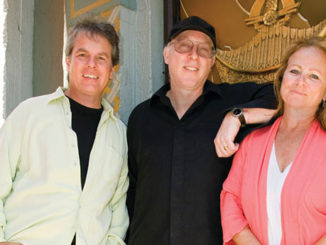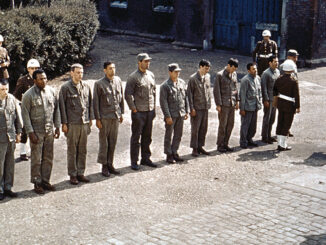
THE YEARS
The 75 Best Edited Films’ years of release range from the 1920s to the 2010s — with 3 titles each in both of those decades. Most of the films cited are from the 1970s (17), followed by the ‘90s (16), the ‘60s (13), the ‘50s (8), the ‘00s (7), the ‘80s (5) and the ‘40s (3). Curiously, there were no films chosen from the 1930s.
Four years account for 3 films each on the list: 1969, 1974, 1999 and 2001. The winning year is 1974, with all 3 of its titles in the top 31 films. There is a run of 15 consecutive years (1968-82) with a film or more on the list for each year. This is followed by 8 years with no films on the list.
THE DIRECTORS
As for directors, Alfred Hitchcock is the most often cited, making the list 5 times (although not placing in the top 10), and spanning 3 decades. Right behind him are Steven Spielberg and Francis Ford Coppola, both of whom made the list 4 times. Like Hitchcock, Spielberg’s pictures were released over 3 decades. Coppola’s pictures, however, were all released in the 1970s — with 2 in 1974 (the only director with 2 films in a single year). All of his pictures placed in the top 22 films, with 3 of them in the top 11. At the other end of the continuum, there were 33 years between Terrence Malick’s 2 films on the list.
Directors Stanley Kubrick and Martin Scorsese follow, with 3 films each making the cut. Tied with Malick for 2 pictures are Bob Fosse, William Friedkin, Akira Kurosawa, Christopher Nolan, Ridley Scott, Steven Soderbergh, Orson Welles and Bob Wise; all others received 1 mention.
THE EDITORS
Mirroring his director/collaborator’s top spot, George Tomasini is the most cited picture editor, with 4 films on the Best Edited Films list — all Hitchcocks and all within a 6-year period. In a 3-way tie for the next most mentions (3) are Dede Allen, Michael Kahn and Thelma Schoonmaker; Allen’s and Schoonmaker’s pictures each span 3 decades.
Thirteen editors had 2 films on the list: Richard Chew, Anne V. Coates, Gerald B. Greenberg, Akira Kurosawa, Ray Lovejoy, Craig McKay, Walter Murch, Sam O’Steen, Jay Rabinowitz, William Reynolds, Daniel Rezende, Pietro Scalia, Billy Weber and Peter Zinner.
Greenberg is the only editor to have 2 films place in the top 10; Murch has 2 in the top 11; Schoonmaker, 2 in the top 15, Chew, 2 in the top 16; and Allen has 2 in the top 20. Coates has the record for the longest period of time between 2 films on the list: 36 years.
THE SOUND
The sound realm, as expected, has many multiple mentions on the Best Edited Films list. Leading the pack is Walter Murch with 6 citations (not including 1 for picture editing) for only 3 films — all of them directed by Coppola — on which he performed sound design, sound montage and re-recording mixing, or combinations thereof. All of his films are in the top22;2 of them are in the top 11.
Right behind him is Howard Beals with 5 sound editor or sound effects editor mentions (most of them uncredited), 3 of them for Coppola films. Beals has the unique distinction of having worked on all 3 films in the winning year of 1974. In addition, in the sound categories, he also has the greatest length of time between his earliest and latest film: 20 years.
A quintet of sound people 4 citations: Larry Blake as supervising sound editor and re-recording mixer (on 2 Steven Soderbergh films), Richard P. Cirincione (2 films in the top 3) as supervising sound editor/sound editor and Tom Fleischman, Andy Nelson and Dick Vorisek (2 films in the top 20) as re-recording mixers (one of Vorisek’s credits is for re-recording supervisor).
Thrice cited for sound work on the list are supervising sound editor Stephen Hunter Flick, supervising sound editor/sound designer Skip Lievsay, re-recording mixer Scott Millan, re-recording mixer Michael Minkler (2 films in the top 15) and sound editor Winston Ryder (2 films in the top 19). There are many sound personnel who were mentioned 2 times. One of them, re- recording mixer Richard Portman, has both of his citations among the top 16 films.
THE MUSIC
In the music arena, Kenneth Wannberg scored 5 mentions on the list (2 films in the top 21), as either music editor or supervising music editor. Three of the films were for Steven Spielberg. Next most mentioned is Jim Henrikson with 3 pictures, on which he was either music editor or supervising music editor. Those with 2 films on the list include John C. Hammell, Michael Tronick and Ted Whitfield. Hammell’s films, in fact, placed in the top 31.
Much thanks and appreciation to Guild member Harry Peck Bolles and freelance contributor Laura Almo for invaluable assistance in compiling the data and credits, crunching the numbers and generally bringing this list to fruition.
And finally, a special shout-out to assistant editor member Nancy Brindley Bhagia, who submitted the most titles closest to the top of the 75 Best Edited Films list; 9 of her 10 film choices made the cut, and placed the highest — all appearing in the top 46.
– The Editor
*ABOUT THE CREDITS
Our goal was to credit only the top personnel in picture, sound and music editorial, and re-recording mixing (if available), along with their directors, for each of the titles on the 75 Best edited Films list. The litany of post crew credits on many of the titles (particularly in sound editorial) precluded us from listing everyone who worked on the films; there is no slight intended.
Given the vagaries of trying to find accurate credit lists for films — especially the early and/or international titles — there are bound to be oversights in our credits. Plus, sound and music were often not credited at all in the nascent days of cinema. if you find an addition, an error or a discrepancy, please contact CineMontage so that we can correct it for the online version of this story and, if need be, run an erratum in the next issue of the magazine. such clarification is more than welcome.





